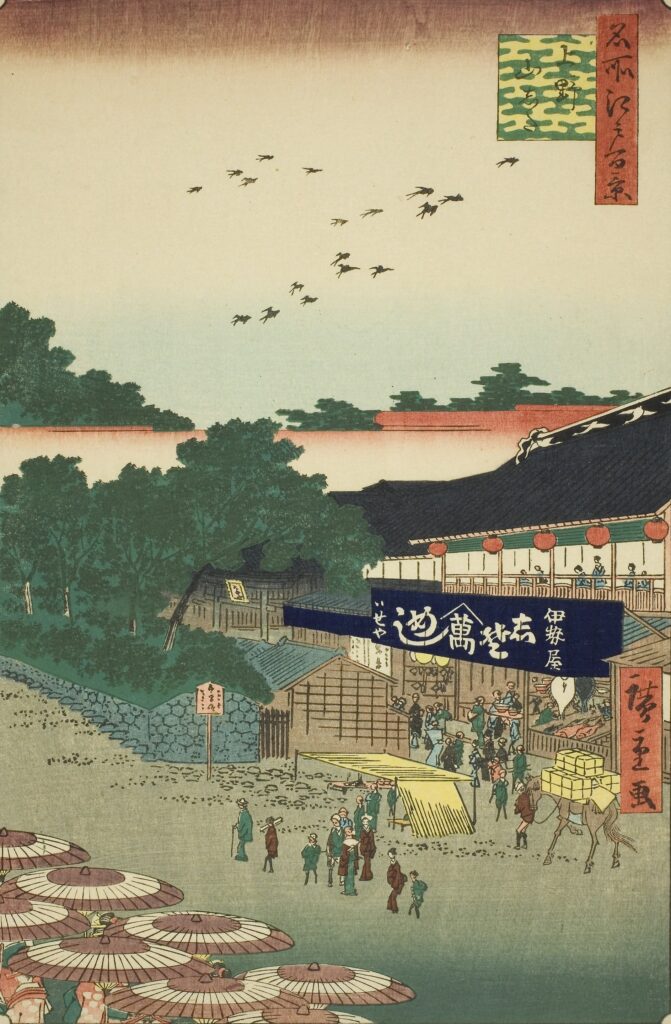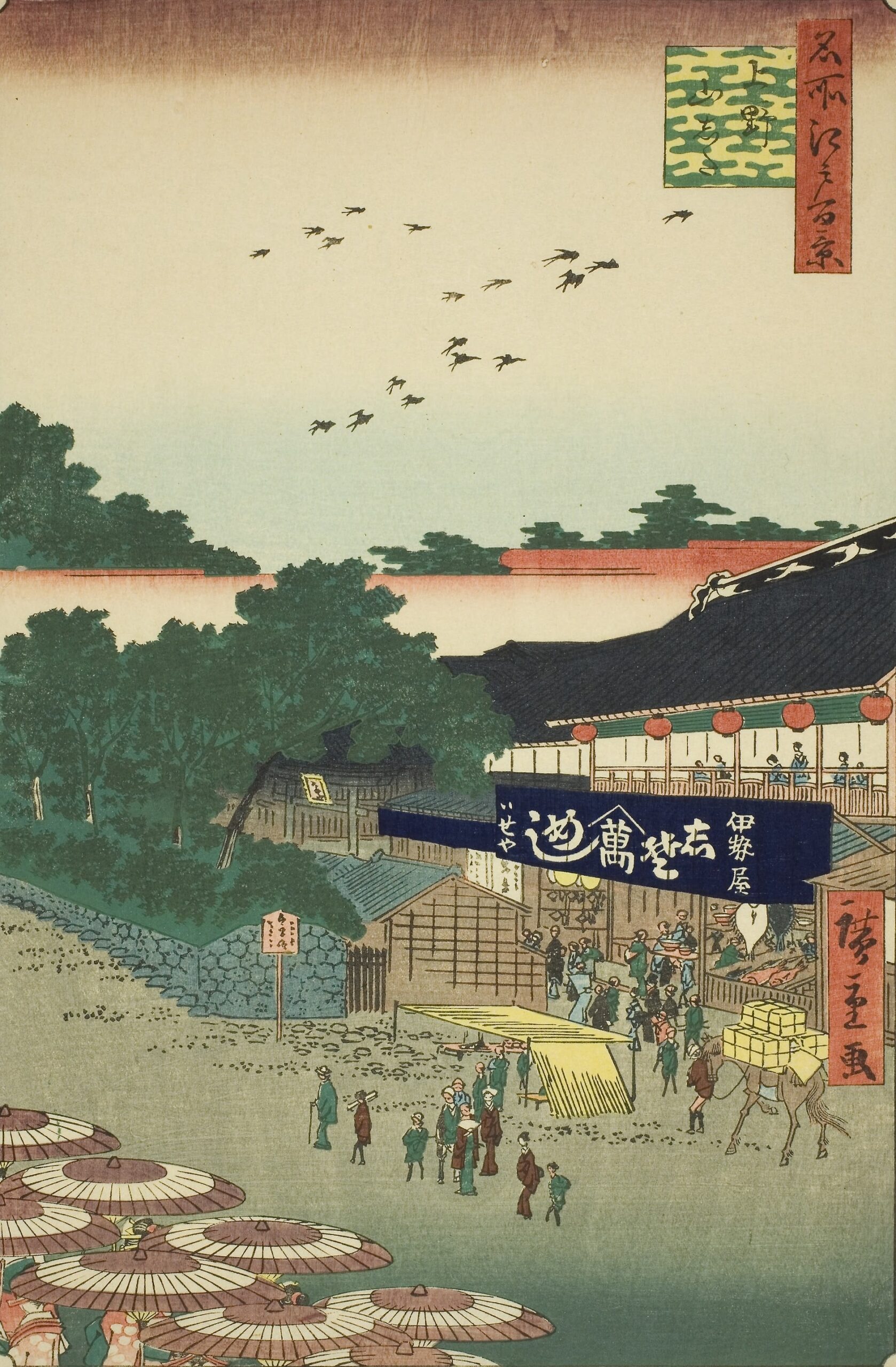
Utagawa Hiroshige – One Hundred Famous Views of Edo – 12 – Spring – Ueno Yamashita – Commentary 歌川広重-名所江戸百景-12-春-上野山した 解説
Current Address: Near Ueno 6-chome, Taito Ward
Latitude and Longitude: Latitude 35.7100, Longitude 139.7730
Published: October 1858 Age: 62
Commentary
<1> Introduction
“Ueno Yamashita” depicts the bustling area around present-day Shinobazu Pond, at the foot of Ueno Hill, a place of relaxation for the common people of Edo.
While it was a place of worship centered around Kiyomizu-do and Kan’ei-ji Temple, the area around the pond was lined with teahouses and street stalls, creating a vibrant landscape where everyday life and entertainment intersected.
Hiroshige captures the daily life and bustle of Edo’s people from the perspective of “Yamashita.”
<2> Uenoyama and its History
Uenoyama (Toeizan Kan’ei-ji Temple) was founded in 1625 by the monk Tenkai as a place of prayer for the Tokugawa shogunate.
It was also the family temple of the Tokugawa shogunate and served as the spiritual center of Edo.
Although the mountain was open to the common people, Ueno was not just a place for samurai and monks.
It was a popular tourist destination for commoners as well, with cherry blossom viewing in spring, cool breezes from the pond in summer, autumn leaves in autumn, and snowy scenery in winter.
The base of Uenoyama was a place of relaxation for the people of Edo.
“Uenoyamashita” refers to the area slightly below the hill where Kiyomizu-do and other temples are located.
Teahouses and food stalls lined the banks of the pond and the approach to the temple, making it a bustling place where people gathered to visit the temple grounds.
Shinobazu Pond and the Scenery of Yamashita
Shinobazu Pond is a natural pond located on the east side of Mount Ueno. Surrounded by willow and cherry trees, it was a popular spot for strolling and boating.
At Yamashita, a teahouse district known as “Ikenohata” spread out, bustling with worshippers and strollers.
With dumpling shops, liquor stores, and theater-like entertainment venues, the area exuded an atmosphere of entertainment and commerce.
Visitors to “Yamashita” would view the pond on their way back from visiting the temple, take a break at a teahouse, take a boat ride, and buy souvenirs.
This beautiful blend of faith and entertainment was a true symbol of Edo culture.
<3> Highlights of the Painting
The people coming and going at Yamashita are depicted in great detail.
Shoppers, families with children, and customers resting at teahouses vividly portray the lives of ordinary people.
The depictions of the teahouse noren curtains and roofs reflect the actual atmosphere of Ikenohata. Teahouses selling dumplings and amazake (sweet sake) were also a part of Edo’s food culture.
This image shows the view that unfolds after crossing the three bridges over the Shinobu River, which flows in front of Ueno Kan’ei-ji Temple.
The shop on the right with the “meshiya” (rice shop) curtain hanging is “Iseya.”
Large fish are displayed on the first floor of the shop, and the second floor is a tatami room where the shiso rice shown under the curtain is served.
The torii gate visible in the shadow of the earthen embankment next to the shop is Gojo Tenjin Shrine.
On the street, a group of women in matching kimonos and carrying snake-eye umbrellas are walking toward the Kan’ei-ji Temple grounds.
<4> Edo Commoners and the Enjoyment of Ueno Yamashita
In spring, the cherry blossoms were in full bloom, and Yamashita was filled with people enjoying cherry blossom viewing.
The cherry blossoms viewed from the stage of Kiyomizu-do were beautiful, but banquets and strolls around the pond were also popular.
Boat rentals were popular on Shinobazu Pond, and families and friends would board to worship at Bentendo Temple in the center of the pond and enjoy the scenery.
Yamashita was close to downtown Edo, making it a convenient stop for townspeople from Kanda and Asakusa.
The teahouse district also served as a place for exchanging information within the city and as a social gathering place in Edo.
<5> Walking around Ueno Yamashita today
Shinobazu Pond still stands today, famous especially for its lotus flowers in the summer.
You can enjoy strolling and boating here, just as in the Edo period.
While the Edo-period teahouse district has disappeared, the place name “Ikenohata” still retains its name.
The surrounding area still houses long-established restaurants and Japanese confectionery shops, giving a sense of Edo culture.
The area, now part of Ueno Park, attracts many tourists as a place where nature and culture blend, along with the zoo, museum, and art gallery.
<6> Tourist Guide
① The setting of Kiyomizu Kannon-do Temple
A great spot to experience the scenery depicted in Hiroshige’s paintings.
② Lotuses and Boats at Shinobazu Pond
Enjoy the scenery throughout the year, from the lotus fields in summer, strolls in spring and autumn, and migratory birds in winter.
③ Bentendo Temple
Bentendo Temple, located on Nakajima Island, is still bustling with worshippers.
④ Stroll around Ikenohata
Experience the Edo-period tourist atmosphere while touring long-established restaurants and sweet shops.

